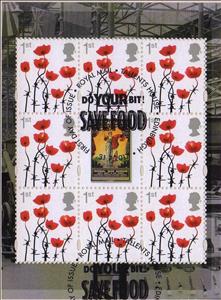Booklet Pane: Mini Sheet (United Kingdom of Great Britain & Northern Ireland 2017)
Mini Sheet (United Kingdom of Great Britain & Northern Ireland 2017)
31 July (United Kingdom of Great Britain & Northern Ireland ) within release The First World War - 1917 goes into circulation Booklet Pane Mini Sheet face value 8*1st No Face Value
| Booklet Pane Mini Sheet in catalogues | |
|---|---|
| Michel: | Mi: GB 2017-08 |
Booklet Pane is square format.
Also in the issue The First World War - 1917:
- Stamp - Dry Docked for Scaling and Painting, by E. Wadsworth face value 1.57;
- Stamp - Nurses Elsie Knocker and Mairi Chisholm face value 1st;
- Stamp - Tyne Cot Cemetery, Belgium face value 1.57;
- Stamp - Shattered Poppy, by J. Ross face value 1st;
- Stamp - Private Lemuel Thomas Rees’s life-saving Bible face value 1.57;
- Stamp - Dead Man’s Dump, by I. Rosenberg face value 1st;
- Booklet Pane - Mini Sheet face value 8*1st;
Booklet Pane Mini Sheet it reflects the thematic directions:
World War I or the First World War (28 July 1914 – 11 November 1918), also known as the Great War, was a global conflict between two coalitions: the Allies (or Entente) and the Central Powers. Main areas of conflict included Europe and the Middle East, as well as parts of Africa and the Asia-Pacific. There were important developments in weaponry including tanks, aircraft, artillery, machine guns, and chemical weapons. One of the deadliest conflicts in history, it resulted in an estimated 30 million military casualties, plus another 8 million civilian deaths from war-related causes and genocide. The movement of large numbers of people was a major factor in the deadly Spanish flu pandemic.
A flower, sometimes known as a bloom or blossom, is the reproductive structure found in plants that are floral (plants of the division Magnoliophyta, also called angiosperms). The biological function of a flower is to effect reproduction, usually by providing a mechanism for the union of sperm with eggs. Flowers may facilitate outcrossing (fusion of sperm and eggs from different individuals in a population) or allow selfing (fusion of sperm and egg from the same flower). Some flowers produce diaspores without fertilization (parthenocarpy). Flowers contain sporangia and are the site where gametophytes develop. Many flowers have evolved to be attractive to animals, so as to cause them to be vectors for the transfer of pollen. After fertilization, the ovary of the flower develops into fruit containing seeds. In addition to facilitating the reproduction of flowering plants, flowers have long been admired and used by humans to beautify their environment, and also as objects of romance, ritual, religion, medicine and as a source of food.

